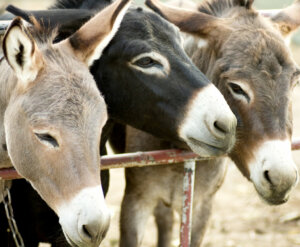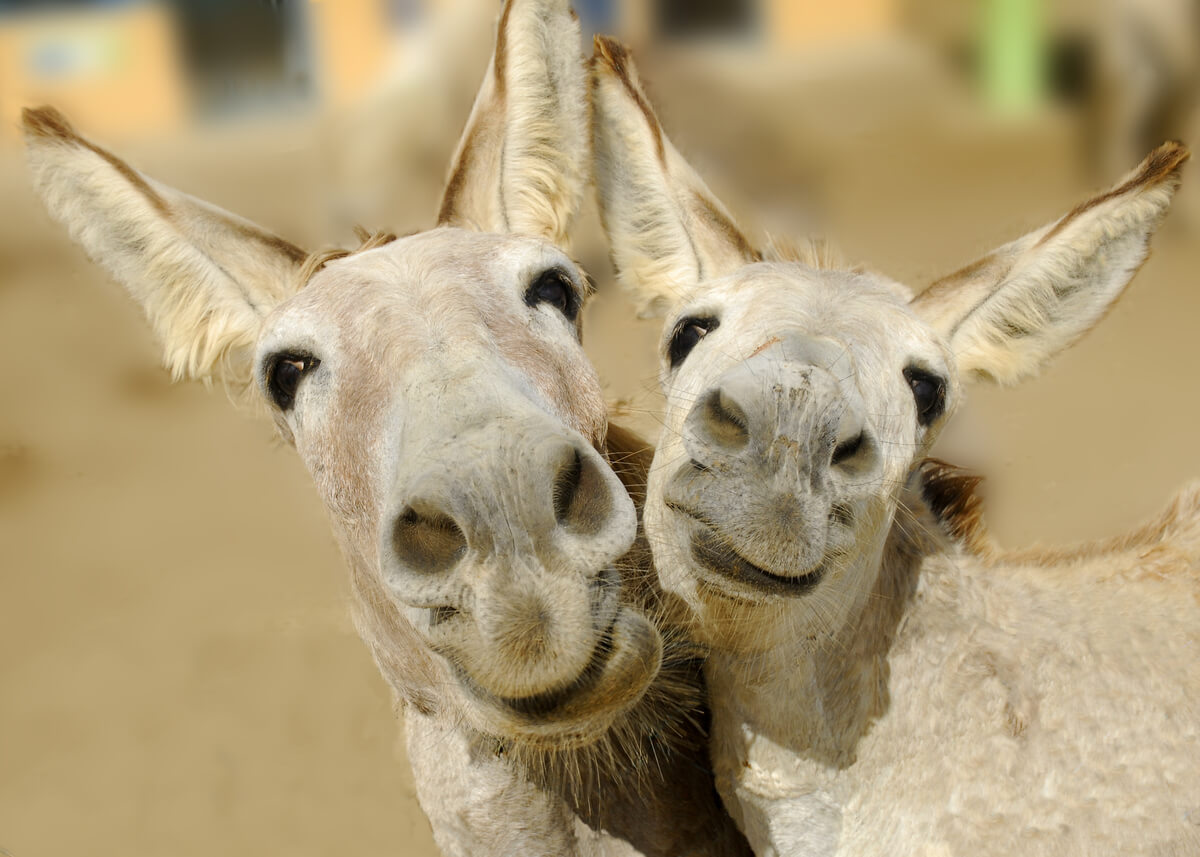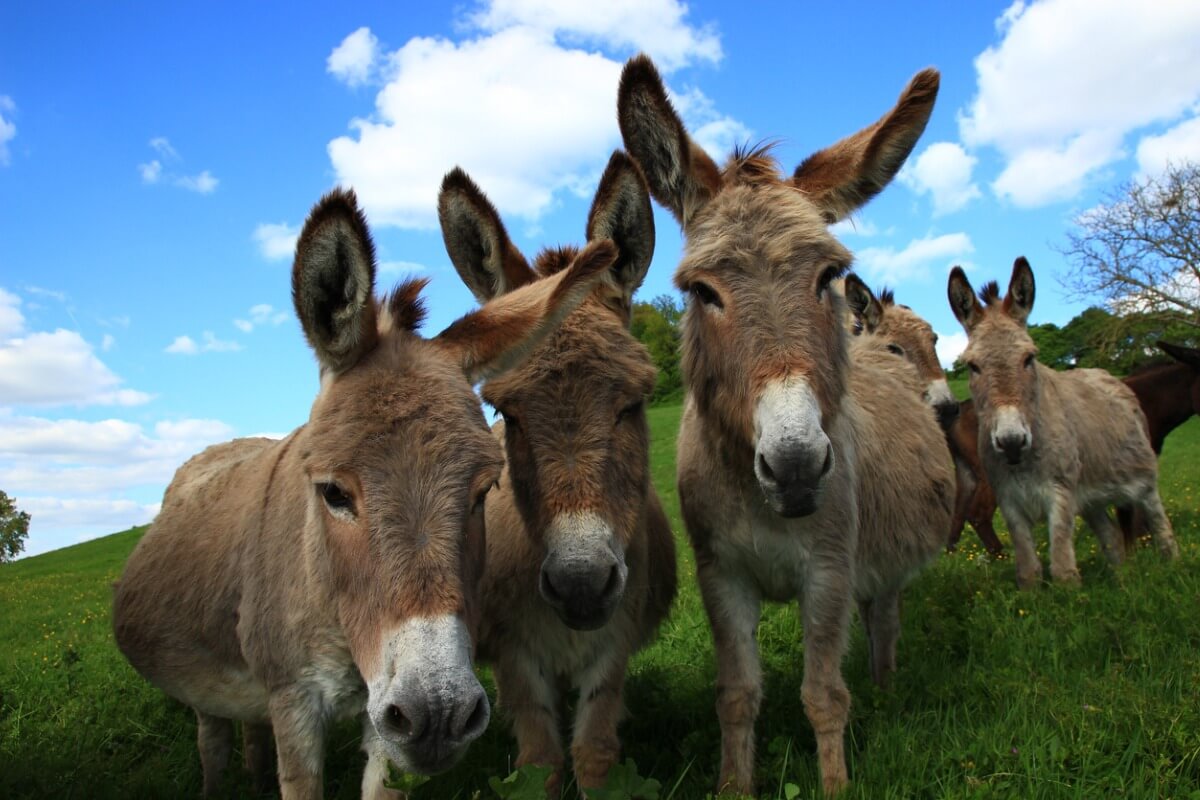Burrolandia: A Refuge for Abused Donkeys

Donkeys are one of the species most exploited by humans. Their use in agriculture and often subsequent abandonment have put this species in danger of extinction. To try to avert this situation, Burrolandia was born, a refuge that welcomes donkeys and gives a new lease of life to these forgotten animals.
In the following lines, you’ll be able to read about how donkeys are used as a work tool and what this interaction with humans has meant for the species. In addition, you’ll get to know first-hand the work that this refuge for neglected donkeys carries out. Don’t miss it!
Why is the donkey a work animal?
Its robustness and the nature of its bone structure make the donkey (Equus africanus asinus) a species susceptible to exploitation by humans, as it can drag up to 4 times its weight. In addition, these mammals are docile animals and their stubbornness is usually a sign of fear, not low intelligence.
Donkeys arrived in Mexico at the time of the Spanish conquest and, as the rights of the natives advanced, these animals became essential in the fields.
However, the progress of agricultural techniques made these cute animals unnecessary for most farmers. This, in turn, as you can guess, led to thousands of abandoned and slaughtered animals.

How was Burrolandia born?
Burrolandia México was born in 2006, thanks to the concern to conserve and protect domestic donkeys. Currently, this sanctuary is home to about 50 donkeys rescued from neglect and mistreatment.
It is a non-profit organization, and is maintained thanks to donations, solidarity tourism, and events. The facility even has a museum dedicated to the species.
This area is unique in Latin America and carries out important educational and conservation work for the species. Located in Otumba, today you can visit both the museum and the animals, to learn the stories of each of its inhabitants —and even stroke and look after them.
Donkey conservation status in Mexico
The census, carried out in 1991 in Mexico, counted about one and a half million donkeys, but today there are only about 300,000 specimens left. The population decline in the last 30 years has been alarming.
Despite being at risk of extinction, there are no conservation programs or protection against neglect and abuse in most countries that have used donkeys for agriculture – and even for consumption. This is because they are considered as part of livestock or as tools.
Burrolandia isn’t the only donkey refuge in the world
Luckily, Burrolandia México isn’t the only sanctuary specialized in donkeys. In other parts of the globe, people are also committed to the conservation of this species. If you’d like to get to know a few examples, keep reading:
- Burrolandia, in Madrid: This sanctuary dedicates its efforts to the same purpose as its namesake in Mexico.
- The Donkey Sanctuary: They have been rescuing and caring for donkeys for 50 years in this UK refuge. They have several locations and a subsidiary in Spain, the Refugio del Burrito.
- Aruba: Located on the island of La Palma, in the country that gives it its name, this sanctuary has been active since 1996.
In general, in any sanctuary dedicated to rescuing animals from human exploitation, you’ll find donkeys among their “residents”. However, if you’re particularly interested in donkeys, then we recommend that you go to a sanctuary specialized in this species.

Donkeys have a reputation for being stubborn, dirty, and unintelligent. However, meeting them in a context where they’re happy reveals their true nature: they’re sociable, affectionate, smart, and very playful animals. If you ever have the opportunity to deal with them, don’t pass it by, as their tender gaze will break down all your prejudices!
Donkeys are one of the species most exploited by humans. Their use in agriculture and often subsequent abandonment have put this species in danger of extinction. To try to avert this situation, Burrolandia was born, a refuge that welcomes donkeys and gives a new lease of life to these forgotten animals.
In the following lines, you’ll be able to read about how donkeys are used as a work tool and what this interaction with humans has meant for the species. In addition, you’ll get to know first-hand the work that this refuge for neglected donkeys carries out. Don’t miss it!
Why is the donkey a work animal?
Its robustness and the nature of its bone structure make the donkey (Equus africanus asinus) a species susceptible to exploitation by humans, as it can drag up to 4 times its weight. In addition, these mammals are docile animals and their stubbornness is usually a sign of fear, not low intelligence.
Donkeys arrived in Mexico at the time of the Spanish conquest and, as the rights of the natives advanced, these animals became essential in the fields.
However, the progress of agricultural techniques made these cute animals unnecessary for most farmers. This, in turn, as you can guess, led to thousands of abandoned and slaughtered animals.

How was Burrolandia born?
Burrolandia México was born in 2006, thanks to the concern to conserve and protect domestic donkeys. Currently, this sanctuary is home to about 50 donkeys rescued from neglect and mistreatment.
It is a non-profit organization, and is maintained thanks to donations, solidarity tourism, and events. The facility even has a museum dedicated to the species.
This area is unique in Latin America and carries out important educational and conservation work for the species. Located in Otumba, today you can visit both the museum and the animals, to learn the stories of each of its inhabitants —and even stroke and look after them.
Donkey conservation status in Mexico
The census, carried out in 1991 in Mexico, counted about one and a half million donkeys, but today there are only about 300,000 specimens left. The population decline in the last 30 years has been alarming.
Despite being at risk of extinction, there are no conservation programs or protection against neglect and abuse in most countries that have used donkeys for agriculture – and even for consumption. This is because they are considered as part of livestock or as tools.
Burrolandia isn’t the only donkey refuge in the world
Luckily, Burrolandia México isn’t the only sanctuary specialized in donkeys. In other parts of the globe, people are also committed to the conservation of this species. If you’d like to get to know a few examples, keep reading:
- Burrolandia, in Madrid: This sanctuary dedicates its efforts to the same purpose as its namesake in Mexico.
- The Donkey Sanctuary: They have been rescuing and caring for donkeys for 50 years in this UK refuge. They have several locations and a subsidiary in Spain, the Refugio del Burrito.
- Aruba: Located on the island of La Palma, in the country that gives it its name, this sanctuary has been active since 1996.
In general, in any sanctuary dedicated to rescuing animals from human exploitation, you’ll find donkeys among their “residents”. However, if you’re particularly interested in donkeys, then we recommend that you go to a sanctuary specialized in this species.

Donkeys have a reputation for being stubborn, dirty, and unintelligent. However, meeting them in a context where they’re happy reveals their true nature: they’re sociable, affectionate, smart, and very playful animals. If you ever have the opportunity to deal with them, don’t pass it by, as their tender gaze will break down all your prejudices!
All cited sources were thoroughly reviewed by our team to ensure their quality, reliability, currency, and validity. The bibliography of this article was considered reliable and of academic or scientific accuracy.
- Geografía, E. D. N. I. Y. (1991). Censo Agrícola-Ganadero 1991. INEGI. https://www.inegi.org.mx/programas/cagf/1991/
- Facebook – Burrolandia. (2021). Facebook. https://www.facebook.com/unsupportedbrowser
- ¿Quiénes somos? (2021). Página web de Burrolandia. https://www.burrolandia.es/protectora-animal/quienes-somos/
- 1960s: The journey begins. (2021). The Donkey Sanctuary. https://www.thedonkeysanctuary.org.uk/about-us/our-story/1960s
- The Open Sanctuary Project, Inc. (2020a, agosto 4). Donkeys: How We Got Here. The Open Sanctuary Project. https://opensanctuary.org/article/donkeys-how-we-got-here/
This text is provided for informational purposes only and does not replace consultation with a professional. If in doubt, consult your specialist.








